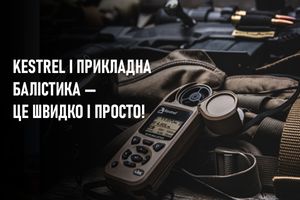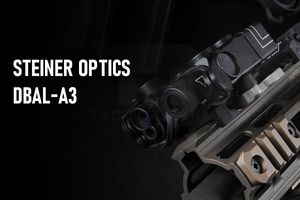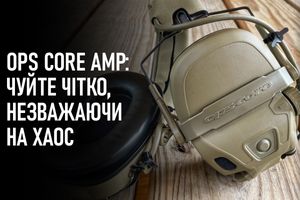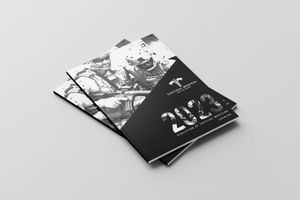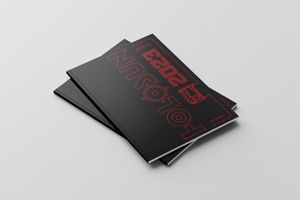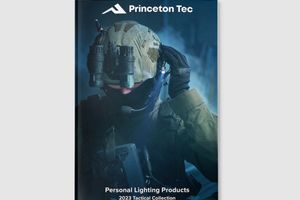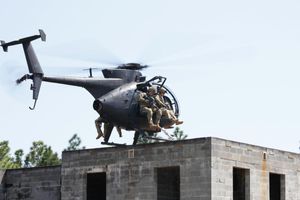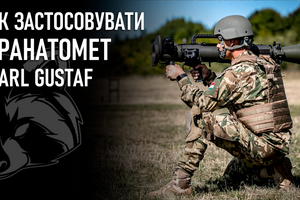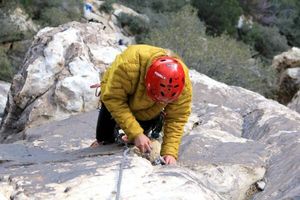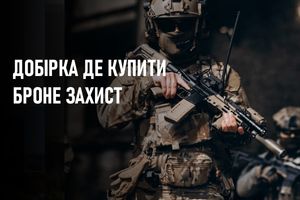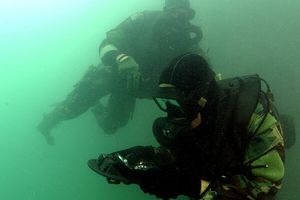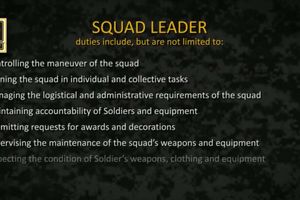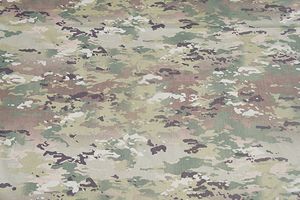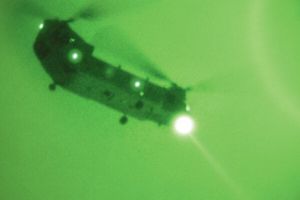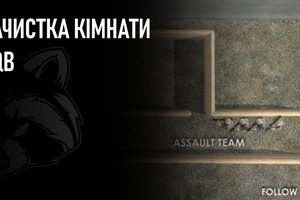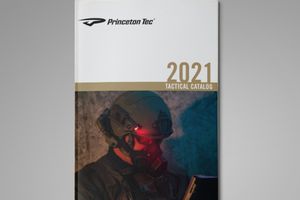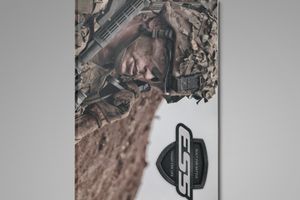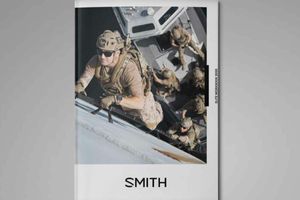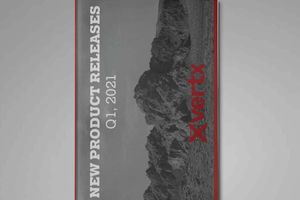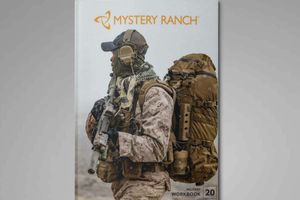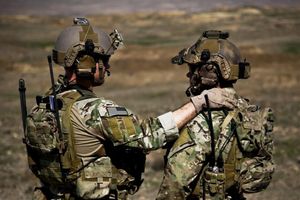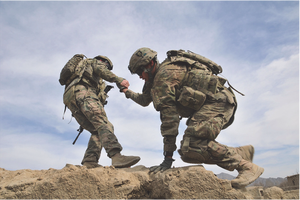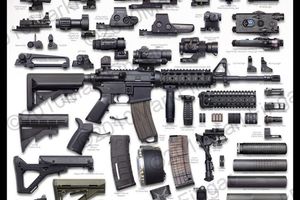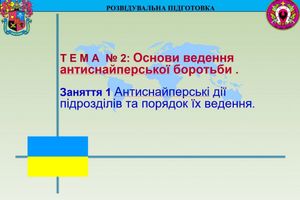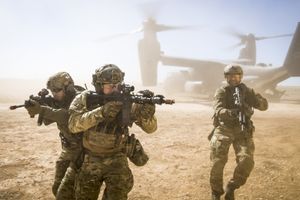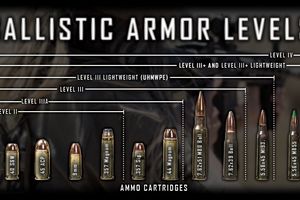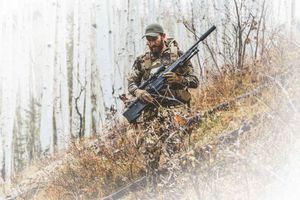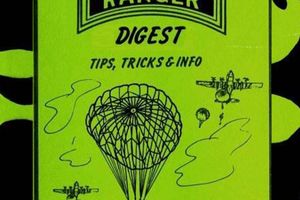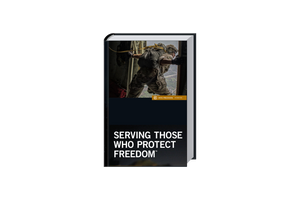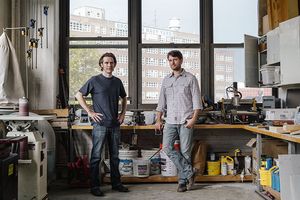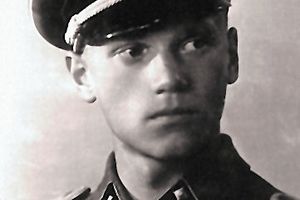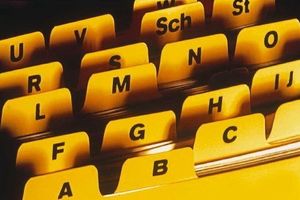Around it was completely dark.
I felt several pairs of eyes staring at me intently. Sweat flowed from his forehead, and from this the fabric of the hood got wet and stuck to his face. People were talking nearby, but about what - I could not make out. All my senses, with the exception of my eyesight, became aggravated, and I was ready to squeeze out everything that could help me when the hood was removed from me.
Before I went to the selection and training course (S & T / selection and training - approx. Per.), I already went on two business trips, including one rotation in Iraq. When it was my turn to start the test, I joined the store with marker cartridges (a bullet - a container with paint, made by General Dynamics, - approx. Per.) To my weapon and headed to the center of the room.

Lamps in it hung from the ceiling beams, which formed bridges, allowing instructors to observe from the side. The floor was marked with special lines, over which meant failure and the end of the test.
On top of my hood was tied with a rope connected to a special roller system. When the instructor pulled the rope, the hood flew off, and I had to react to this or that situation played out in front of me, whether it was a hostage-taking, or the appearance of an unarmed but aggressive person, or quite polite, who, however, could instantly attack me. The scenario could not be predicted.
Unlike BUD / S, which tested the candidate for strength, S&T tested your skills, self-control and the ability to make the right decision against the backdrop of tremendous stress and pressure. I had to quickly assess the situation, select priority threats and act accordingly. And for all this, for each of my actions, instructors watched from above. Every little thing was evaluated. One mistake could be the reason for expulsion from the course and my return to the 5th detachment SEAL.
As soon as the hood fell on my shoulders, I took a deep breath twice and closed my eyes. Having stretched my fingers, I grabbed the handle of the rifle and put my finger on the trigger guard. I tried to relax, because I knew that, being tense, with a head clogged with thoughts, I could make mistakes. I tried not to think: “But what will happen if ...?”. I trusted myself. It was necessary to find the right answer in the question of life and death as quickly as possible and in the right order. The S&T course forced you to go beyond the three-foot world.
Fear and stress are two different things.
One of the keys to managing your fear is to stay inside your three-foot world. But stress is much harder to manage because it comes from an area that you cannot control. The instructors tried their best to drive it into us in such quantity that we could no longer cope with it.
Seconds dragged on, and I was still in the hood. Staying focused was getting harder and harder. It seemed that the instructors were mocking me, forcing me to wait. Maybe they wanted to see how long I would be in a state of readiness. Or maybe they just laughed at me while I was standing here in the hood. I again stretched my fingers, transferred the weight from one leg to another and tried not to be distracted by unnecessary thoughts.
I knew that all the action would take a few seconds, a maximum, a minute, but every second in the hood lasted like a year.
Suddenly, without warning, the hood was pulled off.
A flash of light hit my eyes. I immediately got into the rack and began to scan the room. Not more than 10 feet (~ 3 m - approx. Per.) From me stood a cute blonde. Her brown eyes looked at me. She was wearing jeans and a T-shirt. She smiled as if she knew something that I did not know.
She had no weapons, and I continued to inspect the room. And then in the far right corner of the room I saw an armed man, in his hands was a gun, which was attached to the head of the hostage. The face of the hostage could not be seen.
Without much thought, I threw the rifle to my shoulder and took aim. The red mark of my EOTech lay down on the arrow.
“Hey buddy,” I heard over my shoulder. “Uh, moron!”
“Shit,” I thought.
I didn’t look at what was behind me. - “Whatever, I’m losing control!”
I did not inspect the entire room, focusing too much on the two targets in front of me.
Having removed the rifle from the fuse, I fired two quick shots. Bullets with paint hit the shooter's chest. I knew that first of all I had to deal with the captured hostage. Even if there were armed people behind me, I thought it was much more important. The shooter dropped the gun and fell to the ground, acting out the dead man.
Despite the fact that he was “dead”, I felt that I had adjusted. I did not appreciate the whole situation to the end and hurried. It was hard to procrastinate, at the beginning of my service we learned to do everything at full speed.
During my first trip to Iraq with the 5th detachment of SEAL, during each sortie, we ran to the door or rushed up the stairs with wild ores. Damn, when we arrived in Iraq, nobody in my platoon had any combat experience. For most of us, this was the first business trip and experience was gained already in the process.
We built our camp behind the palace, located on a man-made hill on the outskirts of Baghdad International Airport. From the roof of the palace overlooking the airport. Military aircraft - the large gray S-130 and S-17 - landed on the runway. There was the sound of engines and the roar of helicopter propellers. Baghdad International Airport was a massive transportation hub for Coalition troops. HUMVEE (High Mobility Multipurpose Wheeled Vehicle) and LMTV (Light Medium Tactical Vehicles) trucks lifted up dust on dirt roads leading from airfields to campsites where troops were stationed. All-wheel drive trucks drove back and forth. Every day a new field grew, laden with modular trailers designed to rest or ensure the work of different units.
Special forces occupied the main palace (probably we are talking about Al Faw Palace in Baghdad - approx. Per.). A massive wooden door led into the hall with marble floor. The stairs could go up to the rooms of the second floor. There, in the back of the building, a dining room was organized, and the operations center occupied one of the rooms on the ground floor. Walking around the palace, I noted the skill of the people who built it. However, all that was valuable was stolen by the looters before we arrived. Holes gaped throughout the walls. At the beginning of the invasion, a rumor spread that the water pipes in Saddam's palaces were made of gold pipes, and therefore looters throughout Iraq broke walls in search of profit.
Huge green antennas and satellite dishes were installed outside the palace. Generators were buzzing next to the pool, which separated the main part of the palace and the place where we were located. We occupied the house of the palace service staff near the car park. Like the palace, this house had marble floors, but they were without ornate patterns and did not look so rich. However, this did not stop the marauders from hammering holes in the walls here.
The pool area has become the center of our camp. Between exits on assignments, both SEAL and Green Berets rested here. It was early spring and the heat had not yet arrived. But in the afternoon, the temperature already exceeded 80 degrees (Fahrenheit; approximately + 26 ° C, approx. Per.). We worked at night, but ate, slept, swayed and spent most of the time before getting the assignment by the pool.
Within a few weeks after arrival, we joined the SWAT detachment (special warfare and tactics) in Baghdad and, with the help of the CIA (CIA), searched for and checked suspected rebel activists. The agency tried to identify rebel leaders who were former members of the Ba'ath Party. CIA wanted to earn points, and today we were put on the task.
Around the second half of the mission, we were brought to the detention of a former intelligence officer of the Iraqi Air Force. The CIA informant dressed in dark polo, khaki pants and suede boots brought us up to date. Our goal was to organize attacks in the city against American soldiers. The CIA informant gave a tip to the forces of the Coalition and, having gone through the whole system, it finally came to us. The Iraqi officer was tall, thin and without facial hair, which was rare for Iraq.
The informant had to go ahead of our convoy and point to the right house. We, in turn, had to break into the gates and storm the house. The task is not the most difficult - more screams, more explosions.
We all met at about 11 p.m. for the final briefing and moved forward after midnight. The CIA operative and the informant moved at a decent distance from us in the old-worn sedan. Our squad moved on three HUMVEEs with machine guns mounted on them. My co-worker and I did a little welding and made comfortable thresholds and handles on the roofs on the cars so that when approaching the goal the guys could hold on to them and dismount quickly, like the SWAT squads in Los Angeles.
I rode in the head car. The streets were empty. They were narrow and tangled wires ran along them. Periodically, the antennas of the machines pulled back, clinging to them. It was hard to hear anything behind the rumble of the engines, but suddenly a walkie-talkie spoke.
“OK, this one,” the operative said. - "HISy left" (chemical light sources - approx. Per.).
The HUMVEE engine roared and the car rushed forward to the facade of the building. Even before the stop, I almost got out of the car.
The gates were ajar, crossing a small courtyard, I stopped at the door. I did not pull the handle. A guy from my squad set a blowout around the castle and we both stepped aside.
“Explosions!” He shouted, and seconds later he set the charge on. The door tore off the hinges and knocked inside the house. I did not wait for the smoke to dissipate. A second later I was already inside with arms raised and ready to open fire.
Behind, I heard the guys from my squad making a noise. We were like sharks before feeding. I felt adrenaline stopping me from concentrating. The glasses were fogged up, the spring heat did not subside with stuffiness even after midnight.
The house was beautiful, with marble floors and stairs. Luxurious carpets lay in the rooms of the first floor, and the smell of vegetable oil hung in the air. There were rooms on either side of the lobby. The kitchen was supposed to be at the back of the house, to the right of the stairs leading to the second floor.
Behind myself, I heard my comrades begin to clean the rooms on the first floor. I continued to move towards the stairs.
“Lie down, damn it!” Came the voice of one of ours.
“We caught him!” I heard another. - "Tie his hands!".
The Iraqi Air Force officer was in the ground floor room. He surrendered without any resistance, and the guys from my squad quickly tied his hands. Then they pushed him toward the exit, where the cars were waiting for us. I heard screams of a woman and sobs of at least one child from the room as the boys checked the others.
Our squad leader stood in the center of the corridor and shouted directions.
“Left clean!”
"Right clean!"
"Forward!"
My friend and I went to the foot of the stairs and began to observe.
As soon as we got there, the foyer burst into thunder with AK-47 shots. Bullets hit the marble floor and knocked shards out of it. Behind me, I heard our guys screaming and scattering shelters, and bullets hit the walls and floor just a few feet in front of me. I quickly stepped back from the stairs and felt me crumbled with marble chips and splinters. The roar of the AK-47 echoed across the first floor, smoke and the smell of gunpowder hung in the air, all of which prevented us from concentrating. They shot from the stairs. The shooter was not so much aiming as he was just putting the barrel in our direction and stinging on the descent. None of the shots hit the target, but it did not matter - the shooter was only fifteen feet (~ 4.5 meters - approx. Per.) From us.
I turned in his direction and began to shoot from my M-4 up the stairs in the hope of forcing the shooter to seek cover.
Now at least three of us fired back. Our commander approached and we began to prepare for the assault on the stairs. The shooter had an advantage, we did not know where he was hiding. We had no idea if he was alone, or there were several. Air support, or something like the AC-130, would not hurt us now, but we were in the center of Baghdad. The probability of casualties among the civilian population was too high. The only way out is to storm the stairs and clean the second floor.
Smoke made it harder to see.
The commander ordered the use of stun grenades. These grenades are non-lethal weapons, they simply create a loud sound and stun the enemy for several seconds. They will surely give us a few seconds to storm the stairs.
We had about five to six grenades. They look like small silver tubes with holes in the case. Having pulled out the check of each, we threw them to the second floor. The sound of fired grenades was like the sound of the end of the world. My ears rang and had to yell so that a comrade standing in front of me would hear me.
As soon as the buzz of light and noise began to subside, we looked at each other. It was clear that the time had come to move up the stairs. I took two deep breaths and tried to focus on what was to be done.
The windows of the second floor were knocked out with grenades, the floor was strewn with fragments, and thick, sour, white smoke hung in the air. While we both climbed the stairs, we shot, trying to provide ourselves with this cover.
After making about four shots and passing half the stairs, the M-4 jammed. There was no time to figure it out and I threw off my weapon. The rifle remained hanging on my chest, and I took the gun out of my hip holster.
Sweat streamed down my face, filling my eyes. Holding the gun at eye level, I continued on to the corridor of the second floor, trying not to step on the broken glass. I realized that the enemy could appear at any moment and start shooting again. There was nowhere to hide in the corridor. And as soon as he appears, he will catch a bullet.
On the second floor there were three rooms. At the end of the corridor was a balcony. The guys from my squad were moving behind me. Several "cats" entered the first room on the right side. In it on the floor lay mattresses. I continued to walk slowly along the corridor through the smoke.
As soon as we approached the second door on the right side of the corridor, I went a little further, and the guys went inside. Having reached the last door on the left, we knocked it out and burst into the room. Then I heard screams from the second room. The guys found the AK-47, but the shooter himself was nowhere to be found.
Right in front of me was a door leading to a balcony. I held out my hand and tried to open it. The door was locked on our side. My comrades found the AK-47, but no one knew where its owner had gone.
I tried to think through all the options. Was he wearing a suicide belt? Was there one or more shooters? He was not heard and not visible. I started to get nervous. Where did that bastard go?
He could not go down. I knelt down and tidied up my M-4. Then, opening the lock, I slowly opened the balcony door. Maybe he was hiding there. It never dawned on me how he could flee to the balcony by closing the door from the inside. All of the above happened so quickly that it was difficult for me to keep track of the little things and I did not attach much importance to this moment. Obviously, I overstrained. This whole fight reminded me of a car accident.
When you get into a car accident, you often remember the last two to three seconds before an impact. If you get into an accident again, again and again, then you begin to remember much more details that accompany this event. Circumstances leading to an accident, smells, sounds and speed before a collision.
Skirmishes are somewhat similar to car accidents. You try to avoid them, they are always sudden, and because of the adrenaline rush you find it difficult to stay focused and make the right decisions. This shootout was one of the first for me and I was a little confused.
Having dealt with my M-4, I opened the door and went out onto the balcony.
Nobody. Where the hell is he gone? I reached the end of the balcony, examining the courtyard and the adjacent roof. Below were our cars. He had nowhere to run! The shooter seemed to evaporate.
I went to the other end of the balcony and there I looked out the window of the room where the guys found the AK-47. They were in the room, examining her, looked under the beds and searched the wooden cabinet in the back of the room.
Already about to return back to the house, through the window I noticed a man. He sat on the windowsill and hid behind the curtains that covered the protruding part of the furniture. He was somewhere in twenty years, he was wearing a T-shirt and shorts. The hair on his head was disheveled, and there was a slight unshavenness on his cheeks. His knees were pressed to his chest and he struggled to remain motionless. He sat with his eyes closed and could not even imagine that I could see him.
I threw up the M-4, but I could not shoot. He was unarmed, in addition, the guys from the detachment could suffer from a stray bullet. There was a black metal grill on the window. I stuck the barrel of arms between the bars and broke the glass. The sound of breaking glass frightened him and he looked at me. I took a step back and aimed at his face. He threw back his head, the glass cut his lips and a stream of blood flowed down his chin onto his dirty shirt. He groaned and fell from the windowsill to the bedroom floor. My comrades grabbed him, laid him face down and put on plastic handcuffs. Later we found out that he was the son of an Iraqi officer. Before hiding on the windowsill, he threw his AK-47.
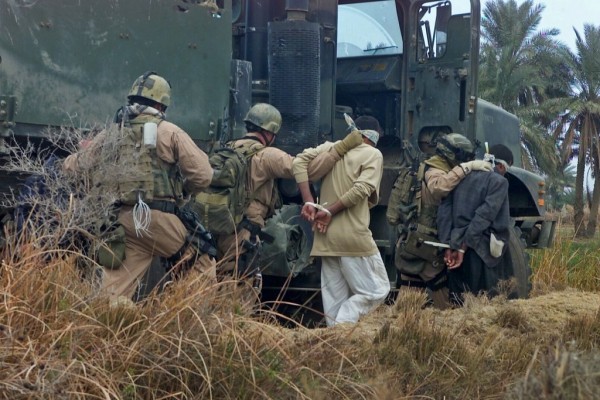
When I returned to the base that night, I could not put my thoughts together. I scrolled what happened in a circle. The guys who discovered the AK-47 were supposed to find their son, but due to the fact that they were all cocked up due to stress, they could not perform the search properly.
After a couple of years, on a test with a hood, I seriously thought about how to deal with stress. I realized that the key to solving this problem is to sort out all the stressors and then work with them. I will crush them into smaller parts that I can handle. What I can’t influence doesn’t bother me. Having broken the problem into parts, I deal with them - one by one. By and large, we again return to the BUD / S course and the story with the elephant.
How can you eat a whole elephant? Bit by bit.
The task of the test with a hood is to bind you. To make very difficult decisions, right or wrong, good or bad, solve life and death issues in seconds. In battle, we encounter similar situations. I always try to take things as they are. I don’t want the guys to become numb when they meet a superior opponent. On the other hand, I don’t want them to open fire without soberly assessing the situation. Look, evaluate the situation, prioritize, break down the task into smaller ones and work with what you can influence and what you can accomplish in the first place. Thanks to constant training, repetition and experience, most SEAL fighters can do this at the instinct level.
As soon as you come to this, everything falls into place.
Let's get back to my hood test on the S&T course. A few seconds after the instructor pulled off the hood, I shot the captured hostage with two shots with paint. This was the first item on my checklist. The next item was the people behind me. I turned around, threw up my weapon at the ready and started screaming:
"Show your hands! Come back, damn it! ”
Men were dressed like the first shooter. However, they were unarmed and immediately raised their hands up. Slowly, in very small and careful steps, they began to back away. As soon as they were a few feet away from me, I ordered them to lie down on the ground.
“Face down!” Spread your arms to the sides! ”
They lay down and I looked back at the blonde, who was holding a gun in front of my face.
“What the fuck are you doing there?” The instructor shouted from above.
Immediately, all the instructors started shouting that I was not acting fast enough. I was careful. I slowly moved from one threat to another and paid for it. Fortunately for me, almost no one passed this test the first time. I flew into my first "car accident" and it was so-so.
I cursed myself for being slow. Having spent too much time on two men, I completely forgot about the woman behind. I did not perceive her as a threat.
However, as the experience of business trips showed, women, especially in Iraq, often hid telephones and weapons. During my first business trip with SEAL 5, we searched the woman after her husband’s arrest and found several pistols and telephones. On the same business trip in Baghdad, four women were detained; during the search, they found suicide belts. A few months after these events in Baghdad, a female suicide bomber, put on a belt in a suburb of Tall Afar, northern Iraq. The rebels knew that we did not search women. After this incident, we decided to search everyone taken under suspicion.
I failed the first test with a hood on the S&T course, but I learned a lesson that I will never forget. Assess the situation, prioritize and act. Throughout my life, service and the lives of other people, I will observe and get into such “car accidents” many more times, encountering various stress phenomena that I could not even imagine during the test with a hood. And I will shoot real bullets, and not harmless paint. And every time I will bear and learn for myself something vitally important.
Source: https://lost-unit.livejournal.com
Posted by: Lost-Unit










































































































































